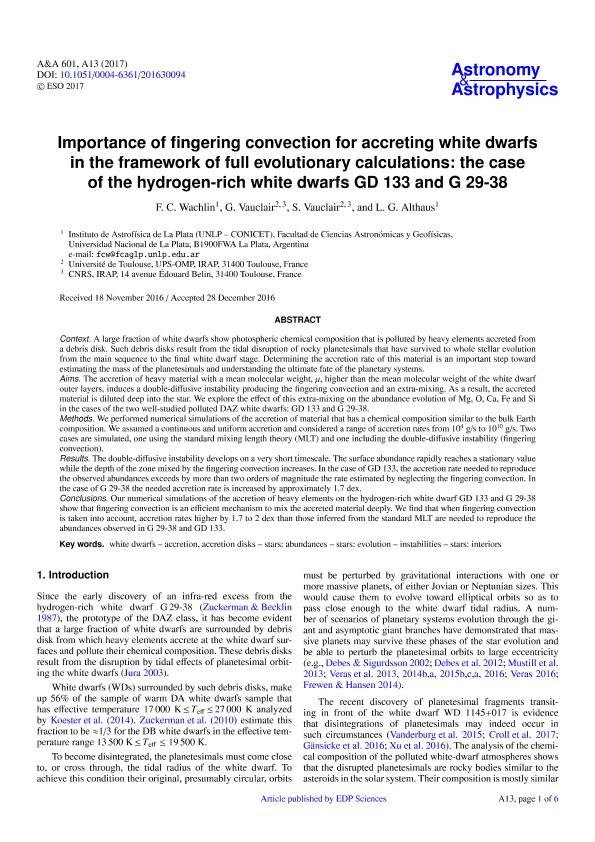Artículo
Importance of fingering convection for accreting white dwarfs in the framework of full evolutionary calculations: the case of the hydrogen-rich white dwarfs GD133 and G29-38
Fecha de publicación:
2017
Editorial:
EDP Sciences
Revista:
Astronomy and Astrophysics
ISSN:
0004-6361
Idioma:
Inglés
Tipo de recurso:
Artículo publicado
Clasificación temática:
Resumen
Context. A large fraction of white dwarfs show photospheric chemical composition that is polluted by heavy elements accreted from a debris disk. Such debris disks result from the tidal disruption of rocky planetesimals that have survived to whole stellar evolution from the main sequence to the final white dwarf stage. Determining the accretion rate of this material is an important step toward estimating the mass of the planetesimals and understanding the ultimate fate of the planetary systems. Aims. The accretion of heavy material with a mean molecular weight, μ, higher than the mean molecular weight of the white dwarf outer layers, induces a double-diffusive instability producing the fingering convection and an extra-mixing. As a result, the accreted material is diluted deep into the star. We explore the effect of this extra-mixing on the abundance evolution of Mg, O, Ca, Fe and Si in the cases of the two well-studied polluted DAZ white dwarfs: GD 133 and G 29-38. Methods. We performed numerical simulations of the accretion of material that has a chemical composition similar to the bulk Earth composition. We assumed a continuous and uniform accretion and considered a range of accretion rates from 104 g/s to 1010 g/s. Two cases are simulated, one using the standard mixing length theory (MLT) and one including the double-diffusive instability (fingering convection). Results. The double-diffusive instability develops on a very short timescale. The surface abundance rapidly reaches a stationary value while the depth of the zone mixed by the fingering convection increases. In the case of GD 133, the accretion rate needed to reproduce the observed abundances exceeds by more than two orders of magnitude the rate estimated by neglecting the fingering convection. In the case of G 29-38 the needed accretion rate is increased by approximately 1.7 dex. Conclusions. Our numerical simulations of the accretion of heavy elements on the hydrogen-rich white dwarf GD 133 and G 29-38 show that fingering convection is an efficient mechanism to mix the accreted material deeply. We find that when fingering convection is taken into account, accretion rates higher by 1.7 to 2 dex than those inferred from the standard MLT are needed to reproduce the abundances observed in G 29-38 and GD 133.
Archivos asociados
Licencia
Identificadores
Colecciones
Articulos(IALP)
Articulos de INST.DE ASTROFISICA LA PLATA
Articulos de INST.DE ASTROFISICA LA PLATA
Citación
Wachlin, Felipe Carlos; Vauclair, G.; Vauclair, S.; Althaus, Leandro Gabriel; Importance of fingering convection for accreting white dwarfs in the framework of full evolutionary calculations: the case of the hydrogen-rich white dwarfs GD133 and G29-38; EDP Sciences; Astronomy and Astrophysics; 601; 2017; A13
Compartir
Altmétricas




